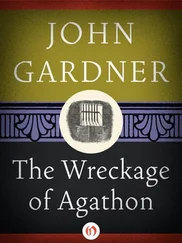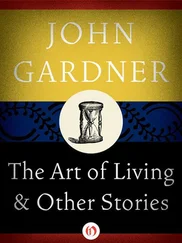“Hello,” the man said, “I’m Murray Weintraub.”
“How do you do!” Craine said, eagerly bowing, almost throwing his arms out to make up for the stillness of the man who stood before him, planted on his small feet (sandals, dark blue socks), like a placid Chinese figurine. He wore a tie, slightly loosened, an Oxford-cloth shirt a little tight at the waist, a woven leather belt on which the buckle was cocked askew. “I’m a friend of Ira Katz — perhaps you know him?” Craine asked.
“I know Ira,” the man said. His expression showed no change, though his use of Ira’s name was as familiar as a relative’s. From his balding, curly head to the soles of his sandals not a muscle moved; he was the soul of non-expression. Even when he shifted his eyes to the right, the movement was expressionless: It was as if he had simply decided to look at something and had looked. “Won’t you come in?” he said, and turned, pushing the door open. When they were both inside, the door falling shut behind them, he said, standing motionless again, “What did you want to know?”
“As I was just now telling your friend out there, I’m not sure,” Craine said. “Who his friends are, what he does here — what all you people do here — what you know about Miss Vaught …” When the man showed nothing, apparently still waiting, still assessing the situation, Craine broke in on himself. “What should I call you, ‘Professor’? ‘Doctor’?”
“Murray’s fine, or professor — whatever you like.” He slightly turned his head, the rest of him unmoving. Craine followed his gaze.
“When did you last see him? — Ira Katz, I mean,” Craine asked.
“An hour ago, maybe an hour and a half,” Weintraub said. He stopped walking for a moment, watching lights flick on and off, then moved forward again. “He was here when McClaren came. They had a long talk.”
“I see,” Craine said. His voice showed nothing of the alarm that leaped up in him. How odd that McClaren had kept it to himself! But no, not really odd. Craine sighed and pushed his hands into his pockets, slowly shaking his head. He’d do the same thing himself, in point of fact. If it moves, suspect it; also if it doesn’t move. What was the saying? To a man who has nothing but a hammer, the whole world’s a nail.
“What does all this do?” Craine asked, waving at the machines.
Professor Weintraub for just an instant smiled. “That’s not easy to explain,” he said. “Briefly, it creates reality. Cup of coffee, Mr. Craine?” Economically — hardly more than the movement of one hand — he indicated a coffee maker, Styrofoam cups, cream and sugar, black and white plastic chairs.
“Why yes, thank you,” Craine said, and at once got out his pipe. Carefully, with gestures as expressionless as his face, Professor Weintraub filled two cups and, at Craine’s direction, added sugar and cream. “I understand,” Craine said when they were seated, “Ira Katz has a fairly ambitious program going.”
“I imagine he does,” Professor Weintraub said. “I’m not familiar with it, but all the programs that come through here are ambitious. It’s all nonsense — practically all nonsense.” His eyes moved, looking around the room, the rest of him quite still. “You’re in Bedlam, Mr. Craine.”
“I see,” Craine said, and waited.
Professor Weintraub raised his cup and drank, then lowered the cup to his knee and sat motionless again. “You asked what we do here,” he said. “It’s an interesting challenge, a question like that. Let me see if I can tell you.” He crossed his legs at the knee and stared at the line where the wall met the ceiling. He sipped his coffee, then — motionless again — began: “I myself came into computers through mathematics. Computers, to me, are simply large, fast calculators. They add, subtract, multiply, and so on; sort things very rapidly, by various criteria; remember things infallibly — in other words, they remember and manipulate formal symbols, figure out the values in a particular case of, say F = ma or E = mc2, to say nothing of equations vastly more complex; and in some cases they show you, on a viewing screen or printout, pictures of what they’re doing or have done. You’ve seen examples — computer games, random patterns … You can get a computer to show you what the planet would look like if you travelled past it faster than, by the Einsteinian laws of energy and mass, it’s possible to travel. We did that once at MIT. Or take a humdrum example. On my office wall I have a map I’ll show you when we get there: it locates all earthquake activity since I960. There’s an interesting point to be made about that; remind me to come back to it.
“Perhaps the best way to get at what we’re after is to explain what computers can do and what they shouldn’t do, not that they can’t (from a certain point of view), and why we’re in trouble when computers are set to doing what they shouldn’t.
“All right, so where are we. What do we do here. We create reality, I said earlier. That’s just about it. Sometimes we do it in fairly innocent ways, running the computations that guide a rocketship and put a man on the moon, or figuring the odds that it will rain and ruin your garden party. In cases like that, the output, so to speak, is that human beings are in closer touch with reality than before, or anyway no further removed from it. The astronaut may have no idea how he got where he got — even the people at the NASA consoles may have no very clear idea, in fact — but that’s moondust under his feet: he’s in touch. That’s usually not how it works with computers: usually the machine takes over for reality, and as the poet says, ‘You can’t go home again.’
“There are two ways to put it. On one hand, the computer transforms the world — transforms it utterly; on the other, it intercedes between the human mind and the world, the ‘old reality,’ if you like, and just sits there, like an impenetrable fog. Let me explain. Start with how the computer transforms the world in the post office, in the Pentagon, in business, everywhere — and I don’t really mean just here in the United States — there had come to be just too much paperwork and too many technical steps in certain jobs, such as automobile building, for human beings to keep up with. Along came the computer and ‘saved the day’—that is, saved the status quo. If the computer hadn’t come along and jacked up the existing welfare distribution systems — hence their philosophical rationales — someone might have thought of eliminating much of the need for welfare by, for example, introducing a negative income tax. But the very erection of an enormously large and complex, computer-based welfare administration created, inevitably, motivation for keeping the system as it was. No politician likes to throw away millions, even billions, of the taypayers’ dollars. Welfare’s a minor example, of course. The most obvious and ludicrous is our so-called military defense system — computer-built, of course — a ‘servomechanism,’ as the Pentagon likes to say, spread out over an area comparable to the whole American continent. You’ve read of it, no doubt: the SAGE air-defense system. Needless to say, once we had SAGE, we had to assume that ‘they’ had one too, so we had to apply our computer technology to designing offensive weapons and strategies that could overpower our own defense, that is, ‘their’ presumed defense, and then we had to assume that ‘they’ had similar weapons and strategies … and so on and so on, through the MIRVs and MARVs, ABMs and forthcoming GKWs … You get the point. Computers have changed the world into something not easy to change back from. The kids in the street yell, ‘No NUKES, no NUKES!’ But they’ve only got one hope, in my opinion: learn math, become computer freaks, learn to guess handshakes and get inside the machines. Because the people they’re yelling at aren’t the ones who do the thinking. The ones who do the thinking are little plastic chips.”
Читать дальше












